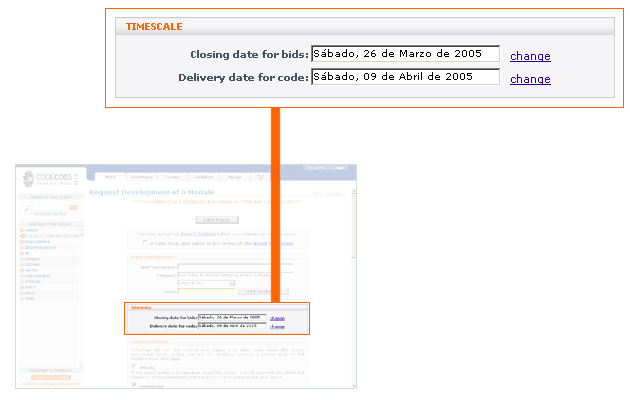When you request a piece of code, other users are
able to bid for the opportunity to work for you. You
then decide if you want to accept any of the bids.
To request a module is easy. Simply click on the  button that is located at the bottom left of the homepage
(as well as various other places across the site). You
will then be taken to a screen where you will be asked
to enter as many details you can about the piece of
code that you are looking for. This page consists of
various sections and is divided up as follows:
button that is located at the bottom left of the homepage
(as well as various other places across the site). You
will then be taken to a screen where you will be asked
to enter as many details you can about the piece of
code that you are looking for. This page consists of
various sections and is divided up as follows:
Module Information
In this section you are asked for a brief description
of what you want the piece of code to do. You will also
be asked to select a category and sub-category that
you think this piece of code will best fit. If you do
not find a suitable category then you can always create
a new one by selecting [new category] from the dropdown
menu, this will reveal a entry box where you can enter
the category name.
All new categories are checked by the CodeCogs
team to ensure that are appropriate!
Finally you will be asked to give the requested piece
of code a name, and check that the name is available
(i.e. it is not already being used by another request
or piece of code that is already in the database.) Try
and be as concise as possible when deciding on a name.
For packages, where several functions are bundled together,
try to chosen a general name that summarises all the
components.
Time Scale
Next you will be asked to enter the date that you would
like the bidding process to end and the date that you
would like the final piece of code to be delivered.
The delivery date will always be later than the closing
date for bids. When selecting a delivery date be realistic
and bear in mind how long you think that the work will
take to complete. If you do not give enough time you
may not get any bids as it might not be possible for
a coder to do the work that quickly.
 |
|
|
Licensing Options
There are several licensing and ownership options available
for you to stipulate when you request a module:
The most common option is to select the “Commercial’
and “Public” boxes. This
means that once the code has been developed it will
be available for other users to use under the terms
of the Free (GPL) or Commercial Licences. To find out
more about the licences please click
here.
It is also possible to request a “Private”
deal. The code will then not be published on CodeCogs.com
once it has been developed.
You can also request “Royalties + Control
Rights” if you wish to receive future
royalties from the code once it has been published.
Note that with private deals, you obtain full ownership
– which includes any copyrights, design rights,
and control rights – you can therefore not select
“Royalties + Control Rights”
and “Private” at the same
time.
 |
|
|
You can also fill in the Anticipated Fee that you expect
to pay for the code. This is only a guide for bidders.
If you are unsure of how much it will cost you can leave
this box blank and wait to see what offers you get.
Detailed Description
In the “Detailed Description” box
you should describe what you want the code to do as
clearly as possible. You can include examples and refer
to other sources of information if necessary. The more
detail you give the easier it will be for bidders to
decide if they want to bid on the project. You are not
restricted for space so use as much of it as you need.
Remember though, that this description is essentially
a draft design specification between you and a potential
developer. When the developers place bids, they will
be asked to refine your description and give precise
details of what they will deliver to you.
 |
|
|
Test Specifications
It is helpful to the coder if you provide some sample
test results that you expect the code to perform. This
makes it clearer and easier for the code to be written
and provides a simple way of testing its functionality.
Once you have fill in all the details all that is left
to do is hit the “Submit Request”
button!
|